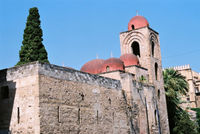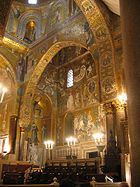Palermo
Palermo or as known locally Palermu, is a historic city in southern region of Sicily of Italy. Palermo is the capital of the autonomous region Sicily and the province of Palermo. The city is known for its rich history, culture, architecture and food, Palermo has played an important role in history throughout much of its existence; it is said to be over 2,700 years old.
Palermo is located in the north-west of the island of Sicily, right by the Gulf of Palermo in the Tyrrhenian Sea.
How to Get here
You can reach Palermo by Air, Sea or by train. Palermo International Airport is located some 32 km west of the city at Punta Raisi. There are flights from all major cities of Italy and some European cities as well. Half hourly shuttle buses provide inexpensive transport into the city centre. There are 1-2 trains per hour, 50 minutes, ?8 (destination Punta Raisi). The usual taxi and car rental services are also available at the airport.
By ferry
Ferries steam between the port of Palermo and the following Italian ports on
a regular basis: Genoa, Civit?vecchia, Naples Malta (Valletta) and Cagliari
(Sardinia).
By Train
Through trains from Rome and Naples via the train ferry across the Messina
straits.
What to see in Palermo
 Mosaic
in Monreale CathedralThe Official site of the museums in Palermo.
Mosaic
in Monreale CathedralThe Official site of the museums in Palermo.
the Cathedral - honey-coloured and Catalan influenced Virtual Tour Cathedral
the Quattro Canti - the symbolic crossroads at the old centre of the city and
the nearby small, but pretty La Martorana church with byzantine mosaics inside.
the Museo Archeologico
The Orpheus mosaicthe Catacombe dei Cappuccini, open daily 9am-12 noon and
3pm-5pm, donation on entry - the catacombs of the Capuchin convent located on
the Piazza Cappuccini, just west of the city centre, contain over 8000 mummified
ex-residents from Palermo and its surrounding villages, some merely clothed
skeletons, other remarkably well-preserved and lifelike. Well worth a visit,
interesting, if slightly morbid. Children may either find it exciting or
terrifying and it must be the responsibility of their parents to think carefully
before taking them.
the Palazzo dei Normanni. Inside, don't miss the mosaics in the Cappella
Palatina and the old Royal Apartments
the 'street markets', especially near the Piazza del Carmine and Vucciria.
Monreale - a village/suburb 8 km west of Palermo, sitting on the hill with a
great view back towards the city and the sea. Be sure to visit the Duomo
(Cathedral) and it's cloisters too.
the Piazza Pretoria, including the Fontana Pretoria
 The
Gesu Church is one of the most architecturally important highly decorated in
Palermo. Constructed between 1564?1633, it's late date of completion resulted in
an abundant use of polychrome marbles on both floors and walls. This form of
decoration, which gradually evolved in Sicily from the beginning of the 17th
century, was to mark the beginning of the Sicilian Baroque period, which was to
give Sicily almost an architectural national identity.
The
Gesu Church is one of the most architecturally important highly decorated in
Palermo. Constructed between 1564?1633, it's late date of completion resulted in
an abundant use of polychrome marbles on both floors and walls. This form of
decoration, which gradually evolved in Sicily from the beginning of the 17th
century, was to mark the beginning of the Sicilian Baroque period, which was to
give Sicily almost an architectural national identity.
Gesu ChurchSan Giovanni degli Eremiti. Via dei Bernadetti. Tel: +39 91 6515019. Old church ruin and nice garden. The ?6 admission ensures that the lovely garden is quiet and peaceful. Open mo-sa 9am-7pm.
Historical Background
The city was founded by the Phoenicians, but named by the Ancient Greeks as Panormus meaning all port. Palermo became part of the Roman Republic and eventually part of the Byzantine Empire, for over a thousand years. For a brief period it was under Arab rule where it first became a capital. Following the Norman reconquest, Palermo would become capital of a new kingdom from 1130 to 1816 the Kingdom of Sicily. Eventually it would be united with the Kingdom of Naples to form the Two Sicilies until the Italian unification of 1860.
The population of the Palermo urban area is estimated by Eurostat to be 855,285, while its metropolitan area is the fifth most populated in Italy with around 1.2 million people. In the central area, the city itself has a population of around 670 thousand people, the inhabitants are known as Palermitans or poetically panormiti, the languages spoken by its inhabitants are the Italian language and the Sicilian language.
The religion of Roman Catholicism is highly important in Palermitan culture, the patron saint of the city is Saint Rosalia, her feast day on July 15 is perhaps the biggest social event in the city. The area attracts significant amounts of tourists each year and is widely known for its colourful fruit, vegetable and fish market at the heart of Palermo known as the Vucciria
Palermo in Ancient era
Ancient Sicani cave art at Addaura.Evidence for human settlement in the area now known as Palermo goes back to the Pleistocene Epoch, around 8000 BC. This evidence is present in the form of cave drawings at nearby Addaura crafted by the Sicani, who according to Thucydides arrived from the Iberian Peninsula (perhaps Catalonia). During 734 BC the Phoenicians, a sea trading peoples from the north of ancient Canaan built a small settlement on the natural habour of Palermo, some sources suggest they named the settlement "Ziz." The Greeks who were the most dominant culture on the island of Sicily, due to the powerful city state of Syracuse to the east, instead called the settlement Panormus. Its Greek name means "all-port" and it was named as so because of its fine natural harbour. Palermo was then passed on to the Phoenician's descendants and successors, in the form of the Carthaginians.
During this period it was a centre of commerce; however a power struggle between the Greeks and the Carthaginians broke out in the form of the Sicilian Wars, causing unrest. It was from Palermo that Hamilcar's fleet which was defeated at the Battle of Himera was launched. Palermo eventually became a Greek colony when Pyrrhus of Epirus gained it during the Pyrrhic War period in 276 BC. However as the Romans flooded into Sicily during the First Punic War, the city became under Roman rule only three decades later. The Romans made sure that, in the words of Roman consul M. Valerian to the Roman Senate; "no Carthaginian remains in Sicily". This period was quite a calm time for Palermo, which was growing into an important Roman trade centre, also during this period Christianity first began to be practised in Palermo.
The Middle Ages
San Giovanni degli Eremiti, domes show elements of Arab architecture.Main
articles: Byzantine Emperor, Emirate of Sicily, and Kingdom of Sicily
As the Roman Empire was falling apart, Palermo fell under the control of several
Germanic tribes; first were the Vandals in 440 AD under the rule of their king
Geiseric. The Vandals had already invaded other parts of western Europe
establishing themselves as a significant force. However, they soon lost these
newly acquired possessions to another East Germanic tribe in the form of the
Goths. The Ostrogothic conquest under Theodoric the Great began in 488; although
the Goths were Germanic, Theodoric sought to revive Roman culture and government
instead. The Gothic War took place between the Ostrogoths and the Eastern Roman
Empire, also known as the Byzantine Empire. Sicily was the first part of Italy
to be taken under general Belisarius who was commissioned by Eastern Emperor
Justinian I who solidified his rule in the following years.
Norman-Byzantine decorated Cappella Palatina.After the Byzantines were betrayed by admiral Euphemius, who fled to Tunisia and begged the Aghlabid leader Ziyadat Allah to help him there was a Muslim conquest of Sicily, putting in place the Emirate of Sicily.[14] The Arab rulers allowed the natives freedom of religion on the condition that they paid a tax. Although their rule was short in time, it was then that Palermo (Balharm during Arab rule) displaced Syracuse as the prime city of Sicily; it was said to have competed with C?rdoba and Cairo in terms of importance and splendor.[15] The Arabs also introduced many agricultural items which remain a mainstay of Sicilian cuisine.[10] After dynasty related quarrels however, there was a Christian reconquest in the form of the Normans from the Duchy of Normandy, descendants of the Vikings; the family who returned the city to Christianity were called the Hautevilles .[14] Palermo was conquered in 831 by Arabs from North Africa and became the capital of Arabian Sicily until 1072 where it was back under Christian rule due largely to the efforts of Robert Guiscard and his army, who is regarded as a hero by the natives.[16] For more than two hundred years Palermo was the capital of a flourishing Islamic civilization.
It was under Roger II of Sicily that his holdings of Sicily and the southern part of the Italian Peninsula were promoted, from the County of Sicily into the Kingdom of Sicily; the kingdom was ruled from Palermo as its capital, with the king's court held at Palazzo dei Normanni. Much construction was undertaken during this period, such as the building of the Palermo Cathedral. The Kingdom of Sicily became one of the wealthiest states in Europe, as wealthy as fellow Norman state the Kingdom of England.[18] Sicily in 1194 fell under the control of the Holy Roman Empire. Palermo was the preferred city of the Emperor Frederick II. Muslims of Palermo were migrated and expelled during Holy Roman rule. After an interval of Angevin rule (1266-1282), Sicily came under the house of Aragon and later, in (1479), the kingdom of Spain until 1713 and between 1717?1718. Palerrmo also managed by Savoy between 1713?1717 and 1718-1720 and Austria between 1720-1734.
Palermo during Two Sicilies and Italian unification
Sicily's unification (1734) with the Bourbon-ruled kingdom of Naples as the kingdom of the Two Sicilies inflicted a devastating blow on the elite of Palermo, as the city was reduced to just another provincial city, the royal court residing in Naples. Palermo rebelled in 1848 and held out against the Neapolitan crown until May 1849.
The Italian Risorgimento and Sicily's annexation (1860) to the kingdom of Italy gave Palermo a second chance. It was once again the administrative centre of Sicily, and there was a certain economic and industrial development. In the second half of the 19th century Palermo expanded beyond the historical centre, especially towards Via della Libert?. Monumental public buildings were erected and a new thoroughfare was cut into the dense old town, called Via Roma. The city was one of the main centres of Art Nouveau style in Italy.
Palermo survived almost the entire fascist period unscathed, but during the Allied invasion of Sicily in July 1943 it suffered heavy damage.
The importance of Palermo got another boost when Sicily became (1947) an autonomous region with extended self-rule. But any improvement was thwarted by the rising power of the Mafia, which still today is a dramatic feature of the city, as well as the whole Southern Italy.

